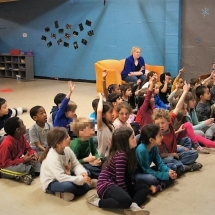Scientists took up the challenge of "les 24 heures de Science"
Once again, the Takuvik Joint International Laboratory rose to the challenge of the recent 24 heures de Science. With the participation of Québec-Océan, researchers and students volunteered for this event, sharing their knowledge with the primary and secondary school students.
Les 24heures de Science, in brief
24 heures de Science is an annual scientific event that enables a large number of people to learn more about science and technology. This year, ecology was the focus of the province-wide event held on May 6 and 7, 2016.
Over the 24 hours, scientists addressed a large and varied audience through hands-on activities, lab tours, lectures, scientific presentations, film screenings …
Students, and the public at large, were invited to satisfy their scientific curiosity about a variety of topics, including biology, health, astronomy, natural sciences, technology, and the environment. For a full list of the events, please refer to the website or the detailed program below.
Apart from this general public programming, 24 heures de Science also offered educational activities in the classrooms of local schools, such as the ones in which Takuvik scientists were involved.
Takuvik at the event
350 children from Fernand-Seguin primary school (from 5 to 11 years old) and a science class of 27 high school students from Rochebelle (12 years old) discovered the Arctic marine food chain, thanks to three members of Université Laval’s NEOlab (Numerical Ecosystems and Oceanography Laboratory), led by Frederic Maps.
Blanche Saint-Béat, Deborah Benkort, and Arnaud Pourchez, enthusiastically shared their knowledge with the young students. Of course, they were not the only ones to roll up their sleeves because other colleagues came to give them a hand.
- Blanche Saint-Béat :
“The aim of my research is  to describe and understand the structure and functioning of different Arctic planktonic communities, allowing to access their stability properties in the face of climate change. Food webs of several Arctic areas are modelled in order to describe properties of planktonic communities.”
to describe and understand the structure and functioning of different Arctic planktonic communities, allowing to access their stability properties in the face of climate change. Food webs of several Arctic areas are modelled in order to describe properties of planktonic communities.”
“I am currently developing biophysical models to get a better understanding of transport mechanisms, aggregation and production of krill (Thysanoessa raschii and Meganyctiphanes norvegica) in the St Lawrence Estuary and the Gulf of St. Lawrence.”
- Arnaud Pourchez :
“The aim of my study is to have a better und erstanding about the growth dynamics of phytoplankton. By studying the relationships of predation and dependence among phytoplankton and zooplankton, I want to gain a better understanding of the role of phytoplankton in its environment.”
erstanding about the growth dynamics of phytoplankton. By studying the relationships of predation and dependence among phytoplankton and zooplankton, I want to gain a better understanding of the role of phytoplankton in its environment.”
Far from being a foregone conclusion, it is with brilliance that the 3 volunteers took up the challenge of inspiring the young public.
Thanks to the tailored activities, the children discovered the Arctic environment and its species, the trophic links between these species and the impact of climate change on the food chain.
For the youngest students, role playing and interaction in the form of questions and answers were part of the program. Through cards hung around their necks, each child took on the role of an animal living in the Arctic. The goal was to reconstitute the food chain in this hostile region by connecting themselves to their classmates with ropes.
The older children participated in group activities and discussions led by the scientists. With more detailed information, students in this class also discovered the concept of the polar night and the adaptation of different plankton to these special conditions. In groups of 5 or 6, the students used their newly acquired knowledge about energy transfer between organisms to create a food chain on a food pyramid which had been distributed to them.
The children’s interest was evident by their enthusiasm and the questions that followed each activity. Mission accomplished for this trio who made research enthralling for next generation of Arctic scientists!
Green Edge spearheads the project !
Through funding and logistical support, Green Edge equipped the graduate students with all the necessary material (rope, posters, various supplies, …) for carrying out their task.
This not the only outreach activity in which Green Edge is involved! During the 2016 ice camp mission, Green Edge scientists will use these same communication tools with children in the community of Qikiqtarjuaq. Other projects, including one involving partner schools in France are planned for both the ice camp and the Amundsen oceanographic mission. the Children in Québec City will not be the only ones to benefit from this opportunity to learn more about Arctic science.























